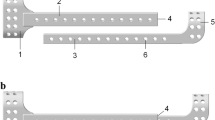Abstract
Bicondylar tibial plateau fractures are difficult to treat with a high complication rate due to difficulties in achieving stable fixation. External fixation methods such as monolateral external fixator, circular external fixators, or a hybrid between a monolateral and a circular external fixator are considered to be good mechanical methods of stabilising these complex fractures. However, main disadvantages of these traditional external fixators are bulky and cumbersome for the patient during daily activities. Therefore, we developed a simple low-profile external device to overcome these drawbacks. ThisTnovel external device is characterized as arced shape proximally and multi-directional screw insertion trajectory to enhance fixation stability of fracture. This study aimed to investigate the biomechanical performence of the novel device and to compare with commercialized traditional external fixator. Finite element method was employed to carry out all biomechanical analyses. Three CAD models of a normal tibia bone, the simple low-profile external device, and a traditional monolateral external fixator were reconstructed. Bicondylar tibia plateau fracture was simulated according to AO classification (AO/OTA type 41-C1; Schatzker type-V). A 1000N axial compression load was applied to the tibial plateau with fully fixed distal end of the tibia. Maximum von Mises stress on bone, screws, and fixators were calculated. The construct stiffness of both groups were calculated also. The results showed that the maximum von Mises stress on implants was much lower than the yielding strength of the material for both groups. The construct stiffness of the novel device (4992.5 N/mm) was 49.8% higher than the traditional external device (3333.3 N/mm). This study demonstrated that the fixation strength of the novel external device was higher than the traditional monolateral fixator. Clinical evaluation for the novel device is still necessary to further verify its usefulness.
Access this chapter
Tax calculation will be finalised at checkout
Purchases are for personal use only
Similar content being viewed by others
Author information
Authors and Affiliations
Editor information
Editors and Affiliations
Rights and permissions
Copyright information
© 2015 Springer International Publishing Switzerland
About this paper
Cite this paper
Lin, W.C. et al. (2015). A simple external fixation technique for treating bicondylar tibial plateau fracture: a finite element study. In: Jaffray, D. (eds) World Congress on Medical Physics and Biomedical Engineering, June 7-12, 2015, Toronto, Canada. IFMBE Proceedings, vol 51. Springer, Cham. https://doi.org/10.1007/978-3-319-19387-8_79
Download citation
DOI: https://doi.org/10.1007/978-3-319-19387-8_79
Publisher Name: Springer, Cham
Print ISBN: 978-3-319-19386-1
Online ISBN: 978-3-319-19387-8
eBook Packages: EngineeringEngineering (R0)




